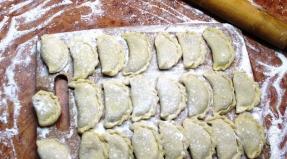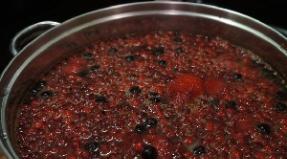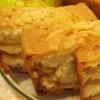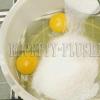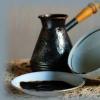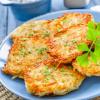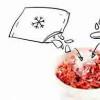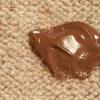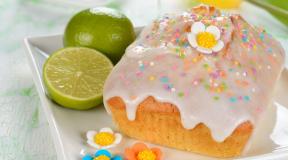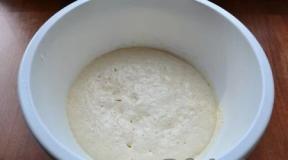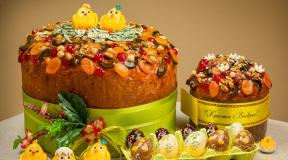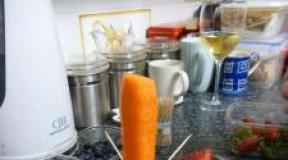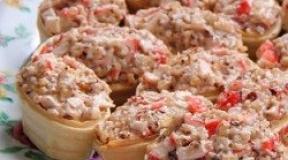Soaking apples at home. Choosing the right cookware
Apples antonovka are not quite an apple variety. Rather, they can be called their "grade type". It has a large number of varieties - ordinary, gray, "Golden Monk", steppe, flat, etc. With the help of it, new apple varieties were bred - "Moscow", "Imbrus", "Bogatyr" and many others.
Apple variety Antonovka"Ordinary" is a fruit of folk selection. The tree is quite tall. In height, it can reach about 5-6 meters. Its crown is round, irregular in shape. The plant begins to bear fruit only at 7-8 years. However, the harvests are immediately rich. The tree needs cross-pollination for large to medium-sized fruits to form. Basically, the fruits are tied on central flowers and have a glassy or flat-round shape. They are greenish in color, and during storage it can change to straw-yellow. The pulp is fruity, aromatic, grainy, yellowish, juicy. For storage, the fruit is removed at the end of September.
Usually, the ripe fruits are chosen for urinating. If the apples are not quite ripe, they can be kept warm before wetting: for apples of autumn varieties, a few days are enough, and winter varieties should be kept for two to three weeks.
It is best to soak apples in wooden barrels or tubs with a volume of 10-20 liters. In the absence of a wooden container, you can use a glass cylinder with thick walls of the same volume. The main thing is that it is hermetically sealed.
The tub or barrel must be soaked in water, then thoroughly rinsed with cold water, and then boiled over with boiling water to eliminate all possible contamination and prepare for long-term storage. Only after that, the barrel is lined with scalded straw, rye or wheat. Straw not only prevents apples from damage, but also gives them an amber color and incomparable aroma. Straw can be replaced with fresh cherry or currant leaves.
For a tub of 15-20 liters, you will need 5 kg of Antonov apples, 2 glasses of sugar, 1 glass of rye flour, 3 tbsp. l. salt with a slide and 15 cherry and currant leaves each. Instead of sugar, you can take 600 g of honey, and add a little lingonberry to the apples, about a handful. It will give them a pinkish color and delicate aroma.
Before cooking, wash the wooden tub well with baking soda and scald with boiling water. Rinse the apples thoroughly. Place some of the cherry and currant leaves at the bottom of the tub. On them densely - a row of apples, and then again a layer of leaves. Fill in this way the entire tub to the top, covering the top layer of apples with leaves.
Boil 10 liters of water in a saucepan, let it cool slightly, add sugar (or honey), salt, stir to completely dissolve the sugar. Add rye flour, stir to avoid lumps and then cool.
Pour brine over the apples, put a wooden circle on top, and a heavy stone (pre-washed) is oppressed on it. Place the apple tub in a warm room (15-18 ° C) and leave for 12-14 days. Skim off the foam daily and add fresh brine as needed. Make sure the apples are completely covered in liquid. This should be done in the first 5 - 6 days, apples absorb water well and the top layer can be bare. If fermentation is normal, after 2 weeks move the apples to the cellar or cold cellar. The room temperature should not rise above 4 - 6 ° С. At this time, the apples will ferment and be saturated with carbon dioxide.
In general, the urination process takes 30-40 days. Pickled apples are stored for quite a long time: in a basement at a temperature of 4-6 ° C, this period can last from autumn to spring. At home, in the absence of a basement, apples are best stored in the refrigerator. Remember, the higher the storage temperature, the faster the apples will acidify, become flabby and tasteless.
MORE RECIPE
For 2 buckets of apples: 1 bucket of water 1 glass of sugar 1 tbsp. salt Dissolve sugar and salt in a bucket of cold clean water, you do not need to boil anything. Prepare the apples - wash, put them in any suitable container, on the bottom of which it is better, of course, to put rye straw. In the absence of such, you can do it, but this is an old Russian recipe, so it's up to you ... The straw and leaves must be clean, so they are scalded with hot water before laying. So, lay the apples on top, sprinkling with washed currant leaves. Pour the prepared filling, the apples will be ready in 3 weeks if ripe.
Pickled apples Antonovka - recipe
Ingredients:
apples (grade Antonovka) - 1 bucket;
sugar - 300-400 g;
salt - 2-3 tbsp. spoons;
leaves and twigs of raspberries, currants, lemon balm and cherries.
Preparation
The best way to cook pickled apples at home is to use enamel cookware. Pour boiling water over it, put half of the leaves and twigs on the bottom, washed apples on top, and then the other half of the leaves and twigs.
To prepare the marinade, put some water on the fire, pour sugar, salt into it and bring to a boil. Let it cool, dilute with cold boiled water and pour over the apples so that the marinade completely covers them. Place the weight on top and add the marinade a little over the next week as the apples will absorb it.
Then put the dishes with apples in a cool place and keep there for at least 1.5 months. Ready-made soaked apples can be a separate dish, or they can be an excellent filler for stuffed poultry or meat.
Soaked apples recipe
In this recipe, we will share a way to make pickled apples in a marinade with the addition of mint, which gives the finished dish a special piquancy.
Ingredients:
apples - 5 kg;
cherry and black currant leaves;
sprigs of mint;
water - 10 l;
honey - 250-300 g;
salt - 150 g;
malt or rye flour - 100 g.
Preparation
Place some blackcurrant leaves on the bottom of the dish in which you will cook the apples, after washing them. Lay the apples on top in two layers, with cherry leaves on them, and then apples again. The next layer is mint leaves (there should be very few of them) and again apples. The last layer can be laid out with a mixture of black currant and cherry leaves, adding a couple of mint leaves to them. Cover all this, for example, with a plate, and put the load on top.
Dissolve honey, salt and malt in warm boiled water. Let it cool and pour over the apples. Keep the container in a cool place for 6-7 days and make sure that the brine completely covers the fruit, top up if necessary. After that, send the pickled apples to infuse in the cold for 4-6 weeks.
Properly cooked, pickled apples have an excellent rich taste and a very pleasant aroma. This method has been known for the future since time immemorial, and is in demand now: it is simple to perform, it takes little time, and soaked apples can be stored for about a year!

They can be an independent dish, used as an additive to desserts, salads and even meat. Not sure how to cook pickled apples? We will give you a hint.
When choosing fruits for harvesting, consider the following recommendations:
- apples must be fresh, without damage or signs of spoilage;
- you will have to pick the fruits by hand, you cannot use those that have fallen from the tree;
- choose white (or “tanned”) late and winter varieties of apples, firm but well-ripened fruits. Summer varieties are not suitable for peeing;
- Wheat (rye) straw used for soaking must be fresh - from a new crop, free of foreign unpleasant odors and mold. Apples, soaked with straw, have a particularly pleasant aroma, piquant taste and beautiful golden color;

- It is not recommended to soak the apples immediately after picking, they need to be allowed to rest for about 3 weeks. During this time, some of the fruits will go to marriage (sick, damaged, and so on);
- using purchased apples for peeing, give preference to, perhaps, less beautiful, but more suitable in quality: grown in private gardens without treatment with various chemicals (to improve the appearance and increase the shelf life). Apples processed with such substances can have an unpredictable taste and, much worse, harm your health;
- it is also better to let the purchased apples rest for a while.
Choosing additives for apples
You can simply soak apples in brine, but it will be much tastier if you add herbs, spices or spices: mustard or honey, flour or sugar, apple, raspberry, lemon balm, currant, cherry and mint leaves, basil, rosemary, oregano, mountain ash, cranberries , rose hips, cinnamon, cloves and so on.Choosing dishes
For wetting apples, it is better to use wooden tubs, glass, ceramic or enamel dishes.
You can take plastic containers, but only if they are intended for food. Naturally, any container should be thoroughly washed before use. First, wooden tubs must be soaked in water, then washed, and after that, be sure to scald with boiling water.
Soaking apples
The process of soaking apples is simple, but, like in any other business, here you must adhere to certain rules and follow the recipe. There are three types of apple peeing:- simple- with the addition of a small amount of sugar and salt to the brine;
- sugar- with the addition of a sufficiently large amount of sugar or honey to the brine;
- sour- without adding sugar or honey to the brine.

Regardless of the type of urination chosen, the process consists of several mandatory stages:
- Apples are washed thoroughly.
- If the recipe contains fresh herbs (black currant leaves, basil, etc.), they are also thoroughly washed, or soaked in cold water for several hours.
- The utensils for urinating are washed with soda, rinsed thoroughly, then scalded with boiling water.
- Apples (stems up) and other ingredients used according to the recipe are placed in the prepared container, filling it to the top.
- Oppression is placed on top of the apples and they are poured with pre-prepared cooled brine.
- Within a month and a half, delicious homemade apples are ready for serving.
- Store the pickled apples in a cool place.
Secrets of Cooking Pickled Apples
- Sugar-sweet apples are more suitable for peeing, as they store much better than sour varieties.
- For the preparation and storage of pickled apples, it is extremely important to comply with the temperature regime. So, the optimal temperature for urinating is +15 ... + 22 ° C. If the room is cooler, the process will slow down; if it is warmer (above + 22 ° C), harmful butyric acid bacteria will begin to develop.
- But the optimal temperature for storing pickled apples is much lower: ideally, it should vary between +4 ... + 6 ° С.

- To prevent pickled apples from spoiling during the cooking process, once a week (and more often) it is necessary to remove the resulting mold, foam, and also wash and scald the load with boiling water (oppression).
- The top layers of apples should always be covered with brine, this should be monitored carefully. The fact is that at first the fruits strongly absorb water, as a result of which the upper apples are exposed. Therefore, at first, it is necessary to ensure that all fruits are covered with brine. If necessary, top it up periodically.
- apples - 20 kg;
- water (cold, well or boiled) - 10 liters;
- basil (twigs) - 100 g;
- honey - 500 g;
- coarse crystalline salt - 170 g;
- rye flour - 150 g.

Recipe:
- Water (if a spring or well is used) is allowed to boil, removed from the fire.
- Add honey, flour and salt to the water cooled to about + 40 ° C, mix everything well. The finished brine is set aside - it must cool completely.
- Apples are washed thoroughly.
- Currant leaves and basil sprigs are picked and washed.
- Part of the currant leaves is laid out on the bottom of a clean container so that they cover it completely.
- Then they are laid, alternating: a layer of apples, a layer of basil, again a layer of apples, and so on.
- After the steeping container is almost completely filled, spread the remaining black currant leaves on top of the fruits.
- Pour in cooled brine, put oppression on top.
- For about 2 weeks they are kept in a room with a temperature of about +15 ... + 16 ° C, after which they are stored in a cool room.
For cooking you will need:
- apples - 20 kg;
- cold water - 10 liters;
- mountain ash - 3 kg;
- sugar - 500 g;
- coarse crystalline salt - 150 g.

Recipe:
- Dissolve salt and sugar in water, boil.
- The prepared brine is allowed to cool completely.
- Rowan and apples are thoroughly washed under running water.
- Put them in a clean container, alternating layers.
- When the container is full, the apples are poured with the previously prepared cooled brine.
- A load is placed on top of the apples.
- They are left for 2 weeks at a temperature of about + 16 ° C, after which they are stored in a cool room.
- apples - 10 kg;
- celery (twigs) - 200 g;
- rye straw - 0.5 kg;
- water - 5.5 l;
- malt - 50 g;
- sugar - 200 g;
- coarse crystalline salt - 80 g.

Recipe:
- Apples and celery are washed under running water.
- The malt is dissolved in 500 ml of water, boiled for 15-20 minutes.
- Dissolve sugar and salt in the remaining water, bring it to a boil, mix with a solution of malt, allow the prepared brine to cool.
- The dishes are washed and poured over with boiling water.
- Rye straw is scalded with boiling water.
- Straw is laid out in the prepared dishes so that it completely covers the bottom.
- Apples are placed in rows on the straw, alternating each layer with celery sprigs.
- On top of the apples, oppression is installed and they are poured with cooled brine so that it completely covers the fruits.
- apples - 10 kg;
- dill (twigs) - 300 g;
- black currant leaves - 200 g;
- water - 5 l;
- sugar - 200 g;
- rye malt - 50 g;

Recipe:
- Greens are washed under running water and laid out on a clean towel so that it dries a little.
- Containers for soaking apples are thoroughly washed and poured over with boiling water.
- At the bottom of the prepared container, spread half of the black currant leaves.
- Apples are spread on them, not forgetting to sandwich each layer with dill sprigs.
- When the container is almost filled to the top, the remaining black currant leaves are placed on top of the apples and oppression is set.
- Rye malt is dissolved in water, brought to a boil and boiled for about 20 minutes, salt and sugar are added, after which the brine is removed from the heat and set aside to cool completely.
- Apples are poured with cooled brine so that it completely covers them. The container is left at room temperature for five days, after which it is stored in a cool room.
- apples - 20 kg;
- water - 10 l;
- sugar - 150 g;
- black currant leaves - 20 pcs;
- cherry leaves - 40 pcs.

Recipe:
- Water is put on fire and brought to a boil, salt and sugar are dissolved in it, and allowed to cool.
- Apples, cherry and black currant leaves are thoroughly washed.
- The cooking container is thoroughly washed and poured over with boiling water.
- The prepared dishes are filled with apples, black currant leaves and cherries, alternating them in layers.
- Pour in cooled brine, set the oppression and remove for 2-3 weeks in a room with a temperature of about +15 ... + 16 ° C.
- Store the apples prepared according to this recipe in a cool room.
- apples - 20 kg;
- water - 10 l;
- rye flour - 500 g;
- mustard (powder) - 150 g;
- mint leaves - 30 pcs.

Recipe:
- Brew rye flour with two liters of hot water, stirring it quickly so that no lumps form.
- Mustard powder and salt are dissolved in a small amount of boiling water.
- The remaining water is boiled and allowed to cool. Then a solution of mustard powder and brewed rye flour are added to it.
- Mint leaves are washed under running water.
- The cooking container is thoroughly washed with soda, rinsed thoroughly and poured over with boiling water.
- Put in a clean container: a layer of mint leaves, a layer of apples, again mint, and so on until it is full.
- The brine is poured, oppression is put on and stored in a cool room (cellar or basement).
- apples - 20 kg;
- water - 8 l;
- viburnum juice (freshly squeezed) - 2 l;
- sugar - 1 kg;
- coarse crystalline salt - 50 g.

Recipe:
- Apples are washed thoroughly.
- They wash a container for soaking with soda, rinse it thoroughly with running water and pour it over with boiling water.
- The apples are laid out with the stalks upward, filling the prepared container to the top.
- Put clean cheesecloth on top of the apples and set the oppression.
- The water is brought to a boil, salt and sugar are dissolved in it and allowed to cool.
- The cooled water is mixed with freshly squeezed viburnum juice.
- Pour the apples (so that the pouring completely covers them).
- Store in a cool place.
- The apples are fully cooked in about 1-1.5 months.
- apples - 20 kg;
- water - 10 l;
- honey - 250 g;
- rye flour - 100 g;
- coarse crystalline salt - 150 g;
- lemon balm leaves - 50 pcs;
- mint leaves - 20 pcs;
- cherry leaves - 20 pcs.

Recipe:
- The container is washed, scalded with boiling water.
- Mint, lemon balm and cherry leaves are thoroughly washed under running water.
- At the bottom of the prepared container, spread half of the cherry leaves, and on top of them two layers of apples.
- Then they are stacked in layers: mint and lemon balm leaves, apples, again leaves, and again apples, and so on.
- The second half of the cherry leaves is put on the top layer, on them - clean gauze, folded in several layers, the load is placed.
- The water is boiled, allowed to cool slightly (to about + 40 ° C), all the ingredients for the brine are put in: salt, honey and rye flour.
- Mix everything well, let the brine cool completely.
- Apples are poured, oppression is set and the container is transferred to a room with a temperature of about +15 ... + 16 ° C for a week.
- Then they are stored in a cool room.
- After about a month or a month and a half, the apples can be served.
- apples - 4 kg;
- sea buckthorn - 200 g;
- pumpkin - 3 kg;
- water - 300 ml;
- sugar - 500 g

Recipe:
- Apples are washed and wiped dry.
- The berries are washed in water and dried by spreading them in a thin layer on a clean towel.
- The dishes for soaking are thoroughly washed, poured over with boiling water.
- Apples are laid out in a clean container, sprinkled with sea buckthorn berries.
- The pumpkin is washed, peeled and seeds removed and cut into small pieces.
- The water is brought to a boil, sugar is dissolved in it, chopped pumpkin is added.
- Boil it until tender, after which, using a blender, beat it into a homogeneous puree along with the broth.
- Pumpkin puree is poured over apples (so that they are completely covered) and oppression is set.
- The apples are kept at room temperature for a week, after which they are lowered into a cellar or basement for further storage.
- apples - 20 kg;
- water - 10 l;
- sugar - 400 g;
- coarse crystalline salt - 100 g;
- rye flour - 200 g;
- cherry leaves - 15 pcs.;
- currant leaves - 15 pcs.;
- lingonberry (berries) - 500 g.

Recipe:
- Apples, currant leaves and cherries are thoroughly washed.
- The dishes for soaking are washed with soda, after which they are thoroughly rinsed and scalded with boiling water.
- At the bottom of the prepared container, place half of the currant leaves and half of the cherry leaves.
- Apples are laid on top of them in rows, sprinkled with lingonberries.
- The top layer is spread with currant and cherry leaves.
- In a small amount of water, rye flour is diluted to a creamy consistency, making sure that there are no lumps.
- The remaining water is brought to a boil, sugar and salt are dissolved in it, rye flour diluted in water is added, boiled for another 2-3 minutes, removed from heat, allowed to cool.
- Pour apples with brine, set oppression and leave for 2 weeks in a room with a temperature of +15 ... + 16 ° С.
- Store pickled apples in a cellar or basement.
- apples - 15 kg;
- water - 10 l;
- cherry leaves - 20 pcs.;
- black currant leaves - 20 pcs.;
- mint (twigs) - 5 pcs.;
- honey - 300 g;
- coarse crystalline salt - 150 g;
- malt - 100 g.

Recipe:
- Apples, black currant leaves, mint and cherries are thoroughly washed.
- The dishes are thoroughly washed with soda, rinsed and poured over with boiling water.
- A layer of half of cherry and black currant leaves is spread on the bottom.
- Apples are spread on them, separating each layer with mint and cherry leaves.
- The last layer is laid out the remaining leaves of black currant, set the oppression.
- The water is boiled, allowed to cool slightly and salt, malt and honey are dissolved in it.
- Apples are poured with ready-made brine, carefully making sure that all the fruits are covered with it.
- The container is left for a week in a room with a temperature of about +15 ... + 16 ° C, after which it is stored in a basement or cellar.
- apples - 10 kg;
- water - 5 l;
- black currant leaves - 50 pcs;
- mustard (powder) - 3 tbsp. spoons;
- sugar - 200 g;

Recipe:
- The water is brought to a boil, after which salt, sugar, mustard are dissolved in it and the brine is allowed to cool.
- The utensils for soaking apples are washed with soda, rinsed and poured over with boiling water.
- The bottom of the container is lined with a layer of black currant leaves.
- Layers of apples are spread on them, filling the container to the top.
- Pour in cooled brine.
- Put gauze on top, set oppression.
- Leave at room temperature for about a week.
- Then transferred to a cool room for further storage.
- apples - 10 kg;
- wheat straw - 500 g;
- rosemary (twigs) - 10 pcs.;
- bay leaf - 5 pcs.;
- water - 5 l;
- sugar - 200 g

Recipe:
- Apples and rosemary sprigs are washed under running water.
- The container for urination is thoroughly washed with soda, after which it is rinsed in running water and scalded with boiling water.
- A brine is prepared from boiling water, salt and sugar, and allowed to cool.
- The wheat straw is scalded with boiling water.
- Part of the straw is laid out on the bottom.
- Then put apples, interlayering each row with straw, rosemary sprigs and adding bay leaves.
- Oppression is placed on top of the apples, poured with cooled brine.
- Take the container to a cool room for later storage.
- apples - 10 kg;
- rye straw (or wheat) - 0.5 kg;
- malt - 50 g;
- sugar - 0.7 kg;
- water - 5.5 l;
- coarse crystalline salt - 80 g;
- mustard (powder) - 2 tbsp. spoons.

Recipe:
- Apples are washed thoroughly under running water.
- The container is washed with the addition of soda, rinsed with clean water and scalded with boiling water.
- Rye straw is also poured over with boiling water.
- Half of the rye straw is placed on the bottom of a container prepared for wetting.
- Apples are placed on top of the straw. When they fill the container completely, they put the second part of the straw on top and set the oppression.
- The malt is dissolved in 0.5 l of water, brought to a boil, allowed to boil for 20 minutes. over low heat.
- Brine is prepared from the remaining water, sugar and salt, allowed to boil, and then removed from the heat.
- The prepared brine is combined with a solution of malt, mustard powder is added, mixed well and allowed to cool completely.
- Apples are poured with cooled brine.
- The container with the blank is removed for storage in a cool room.
- apples (medium size) - 3 kg;
- cabbage - 4 kg;
- carrots - 100 g;
- sugar - 2 tbsp. spoons;
- coarse crystalline salt - 3 tbsp. spoons.

Recipe:
- The cabbage is shredded.
- Apples are washed thoroughly.
- Carrots are peeled, washed and grated on the largest grater (or on a Korean carrot grater).
- Prepare a vegetable mixture: put chopped cabbage, chopped carrots, sugar, salt in one bowl and knead until the cabbage lets out the juice.
- Apples are placed in a clean container for soaking, layering them with a vegetable mixture (the top layer should be vegetables).
- Then they tamp everything a little with their hands and set the oppression.
- Pour the juice released from the vegetable mixture. If it is not enough, prepare a brine: take 1 tbsp for 200 ml of cold water. a spoonful of sugar, 1 tbsp. a spoonful of salt.
- Apples with cabbage are kept at room temperature for 10-12 days, after which they are transferred to a cellar or basement for subsequent storage.
- apples - 10 kg;
- tarragon (twigs) - 10 pcs.;
- rye or wheat straw - 0.5 kg;
- water - 5 l;
- coarse crystalline salt - 80 g;
- sugar - 200 g

Recipe:
- The water is brought to a boil, salt and sugar are dissolved in it, removed from the heat.
- Apples and tarragon sprigs are thoroughly washed.
- The cooking container is washed with soda, after which it is thoroughly rinsed and poured over with boiling water.
- Straw is scalded with boiling water.
- Straw is placed in the prepared dishes, then apples are laid out, not forgetting to add tarragon sprigs.
- Then oppression is set on the apples, they are poured with cooled brine (it should completely cover the fruits).
- Store in a cool place.
- The apples will be ready in about a month.
- apples - 10 kg;
- parsnip (root) - 300 g;
- wheat straw - 0.5 kg;
- water - 5 l;
- sugar - 300 g;
- coarse crystalline salt - 100 g.

Recipe:
- They wash the apples.
- The parsnip root is thoroughly washed, peeled, each cut in half.
- Prepare a brine: dissolve salt and sugar in boiling water.
- The container for making soaked apples is washed in a soda solution (20 g of soda per 10 liters of water), rinsed under running water and poured over with boiling water.
- The wheat straw is scalded with boiling water and placed on the bottom of a prepared container.
- Apples are laid on top of the straw in rows.
- When the container is filled to the top, oppression is set.
- Pour apples with cooled brine.
- Put away for further storage in a cool room.
Pickled apples with kefir
For cooking you will need:- apples - 20 kg;
- water - 10 l;
- kefir - 200 ml;
- mustard (powder) - 3 tbsp. spoons.

Pickled apples with kefir
Recipe:
- The utensils for urinating are thoroughly washed and poured over with boiling water.
- The water is brought to a boil and allowed to cool.
- Apples are tightly placed in a prepared container.
- Put clean gauze on the top layer and set oppression.
- Prepare the filling: cooled boiled water is mixed with kefir and mustard.
- Pour in, making sure that all the fruits are completely covered with the fill.
- Store apples with kefir filling in a cool room.
- apples - 20 kg;
- water - 9 l;
- sea buckthorn juice - 1 l;
- sugar - 1 kg.

Recipe:
- Apples are washed under running water.
- The container for moistening is thoroughly washed with soda, rinsed and poured over with boiling water.
- Apples are placed in the prepared container with the stalks upward, filling the container to the top.
- The top layer of the fruit is covered with a clean plain cloth or gauze and the oppression is set.
- Dissolve sugar in boiling water, let it cool.
- Then it is combined with freshly squeezed sea buckthorn juice, mixed well.
- Pour apples so that they are completely covered with liquid.
- Immediately after preparation, the workpiece is taken out into the cold, where the subsequent time is stored.
- After about a month, apples with sea buckthorn juice are ready.
- apples - 1.5 kg;
- mint (twigs) - 2 pcs.;
- cinnamon (stick) - 1 pc.;
- cloves - 5 pcs.;
- malt - 2 tbsp spoons;
- honey - 4 tbsp. spoons;
- coarse crystalline salt (with a small slide) - 2 tsp;
- water - 2 l.

Recipe:
- Apples and mint sprigs are thoroughly washed.
- The container for moistening is washed with soda, rinsed and poured over with boiling water.
- Apples are placed in a clean container (stems up), not forgetting to add mint, cinnamon and cloves to them.
- Dissolve the malt in water, bring it to a boil, let it boil for about 10 minutes.
- Then put honey and salt into it, stir until completely dissolved.
- Remove the fill from the heat and allow it to cool to room temperature.
- Pour over the apples so that they are completely covered.
- The container is closed with a lid (if apples are cooked in a jar), or oppression is set if a saucepan, barrel is used for cooking, and so on.
- Store in a cool place.

This video shows and explains in detail the process of making pickled apples:
I hope that among the proposed recipes you will find one that suits your taste. Although, of course, not all are listed in the article, in fact there are many more! Experiment with the ingredients: change their quantity and composition, try new flavors. And also do not forget to share the secrets of your favorite blanks in the comments, for sure every hostess has a branded recipe for soaked apples.
The article is posted in sections:,
The Soaked Apple recipe is a great way to harvest fruit for the winter. Unfortunately, today few people use this method and it is completely in vain. Pickled apples are a tasty and very healthy delicacy, which is not at all difficult to prepare at home.
Delicious pickled apples at home - simple recipes for everyone
The benefits of pickled apples are very great. Apples, especially those soaked with sour berries like cranberries, are high in ascorbic acid. Therefore, eating pickled apples is good for preventing colds. In addition, pickled apples improve appetite and normalize the gastrointestinal tract. And the calcium contained in such fruits prevents the development of osteoporosis.
In the old days, apples, necessarily late autumn and winter varieties, were soaked in oak barrels, on the bottom of which a layer of rye straw was laid. In a modern apartment, this method is very difficult. However, there are many simplified and adapted recipes for making soaked apples that can be easily repeated at home.
Soaked apples with honey recipe
Apples cooked with honey are attractive to look at and very aromatic thanks to the cinnamon used in the recipe.
You will need : 1.5 kg of apples, 200 ml of honey, 3 cinnamon sticks, 0.5 tbsp. l. salt, 1 liter of water.
Preparation... For brine, combine water with salt and cinnamon, bring to a boil, and then cool to room temperature. Add honey and stir well to melt. Place the washed and dried whole apples in a jar, cover with brine, cover and leave to ferment at room temperature for 10 days. Store the cooked pickled apples in a cool dark place.
Pickled apples with mustard

Mustard gives the pickled apples a special piquancy and an attractive yellowish color.
You will need : apples, 3 tbsp. l. mustard powder, 5 tbsp. l. salt, sugar to taste, 10 liters of water.
Preparation... Mix water with salt, sugar and mustard, bring to a boil, stirring occasionally, then cool the resulting brine. At the bottom of the container, if desired, lay out the leaves of black currant and cherry, on top lay the apples tightly, pressing them with a load. Pour the prepared brine over the apples so that the load is covered with liquid and leave at room temperature for 1-1.5 months. Check apples periodically and skim off any foam that builds up.
Pickled apples with cabbage

This recipe is good because cabbage is also fermented with apples - an excellent appetizer for meat dishes.
You will need : 5 kg of apples, 10 kg of cabbage, 1 kg of carrots, cranberries to taste, 3 tbsp. l. caraway seeds, 270 g of salt, 5 liters of water.
Preparation... Chop the cabbage, grate the carrots on a coarse grater, mix everything, add the caraway seeds and 200 g of salt. Place a layer of cabbage on the bottom of the container and tamp well until the juice comes out. Place a layer of apples on top. Repeat the layers, the top layer should be the cabbage layer. For brine, dissolve 70 g of salt in water, pour apples and cabbage, put the load on top and put it in a cool dark place for fermentation. Pickled apples will be ready in 4-6 weeks.
Pickled apples in straw

Thanks to the use of straw, the apples are golden, with a special unique taste and aroma.
You will need : 10 kg of apples, 200 g of straw, 4 tbsp. l. salt, 1 tbsp. sugar, 5 liters of boiled water.
Preparation... Pour boiling water over the straw beforehand and dry well. Place a layer of straw on the bottom of the container, then a layer of apples, and again a layer of straw. Repeat the layers, there should be straw on top. Place a cloth, a wooden circle, and a weight on it. Pour the brine over the apples in the straw. For brine, mix cooled water with sugar and salt dissolved in it. Place the bowl of apples in a cool place and once a week, skim off the foam and rinse the wooden circle to prevent mold from forming. Pickled apples will be ready to eat in a couple of months.
Pickled apples in jars

To soak apples in jars, use small, firm flesh.
You will need : apples, 200 g rye flour, 2 tbsp. l. salt, 10 liters of water.
Preparation... Rinse the apples, dry them and place them tightly in 3-liter jars. For brine in a saucepan, mix flour and salt and, stirring occasionally, pour boiling water over. Stir so that there are no lumps, then let stand and strain the brine through cheesecloth. Pour apples with cooled brine, place a load on top (for example, a plastic bottle with water) and put the jars in a dark, cool place for 1-1.5 months. Then remove the oppression, close the jars with regular lids and store in the refrigerator or cellar.
Pickled apples in a barrel

If, nevertheless, you are lucky enough to cook pickled apples in a barrel, rinse it thoroughly with baking soda and scald with boiling water.
You will need : 5 kg of apples, 150 g of salt, 300 g of honey (or 150 g of sugar), 100 g of rye flour, 10 liters of water, cherry leaves, black currant to taste.
Preparation... Place a layer of currant leaves on the bottom of the barrel, then a layer of apples. Lay a layer of cherry leaves on top and a layer of apples again. Repeat layers and press down all with the weighted lid. For brine, mix boiled water with salt, honey and flour and cool completely. Without removing the load, pour the brine over the apples to completely cover the lid with the load. Place the barrel of apples in a slightly cool room for 4-6 weeks.
Instant Pickled Apples

Unfortunately, you won't be able to prepare pickled apples quickly, but using rye bread will significantly speed up the process.
You will need : 1.5 kg, half a loaf of rye bread, 2 tbsp. l. salt, 2 tbsp. l. honey, black currant leaves, 2 liters of water.
Preparation... Cut the bread into cubes, dry in the oven and cover with boiling water, add honey, salt and leave for 2-3 hours. Place currant leaves at the bottom of the jar, place apples on top. Strain the prepared filling through cheesecloth and pour apples into it. Cover and refrigerate for a couple of weeks. Add cold boiled water to the jar from time to time. Store ready-made pickled apples in the refrigerator for 2-3 months.
As you can see, there is nothing difficult in making soaked apples at home. Try and harvest this old way!
See also, tasty preparations.
The process of wetting fruits and berries is the same as when pickling and pickling vegetables. Since childhood, I remember the taste of soaked apples fermented by my grandmother - tasteful, cooking pickled apples the process is simple, but there are small subtleties and tricks.
The essence of urination (fermentation) is that, thanks to yeast and lactic acid bacteria, part of the sugar in berries and fruits passes into lactic acid (0.5-1.5 percent) and alcohol (1-3 percent), and this preserves the soaked fruits. In order for them to be better preserved, it is necessary that as much lactic acid and alcohol as possible accumulate in the fruits.
When lactic acid accumulates in the fruits during fermentation, they become sweet and sour. Carbon dioxide and alcohol give them a refreshing taste. Before fermenting the fruits, you must thoroughly wash the container, store and care for the soaked berries and fruits correctly, otherwise they will acquire an unpleasant aftertaste of acetic acid and the smell of spoiled silage.
This is acetic acid fermentation and the alcohol becomes acetic acid. The smell of spoiled silage occurs when butyric acid fermentation occurs, in which case sugar and lactic acid are converted to butyric acid. This can be the case when the fruits are fermented at a temperature of 30 degrees and above. My grandmother did not take pickled apples into the basement, but cooked everything right in the basement.
Pickled apples
Apples should be dense, medium-sized and sour in taste. Apples harvested from the tree cannot be wetted immediately, they must lie down a little so that the starch in the apples turns into sugar. You just need to pick the fruits, those that have fallen from the tree are not good.
Ranet Semirenko, Ranet champagne, Zelenka, Babushkino, Anis, Antonovka, Aport, Pepin Lithuanian and others are considered good varieties for fermentation. Apples should only be white, colored or tanned; summer varieties are not suitable.
Sort apples by quality and size and wash. Wash apples that have been treated with chemicals especially thoroughly. Well, the introduction turned out to be long, but everything is important, now how to cook pickled apples all the subtleties and tricks of cooking.
Prepare wheat or rye straw. Straw protects apples from damage and affects taste, color and smell pickled apples... They acquire a golden color, a specific pleasant smell and taste. The straw should be freshly harvested, free from mold and odor. For 100 kilograms of apples, take 2 kilograms of straw, having previously scalded it with boiling water.
Soak the barrel in which the apples will be soaked, rinse with hot water, then rinse with a hot solution of caustic soda (20 grams of soda per bucket of water), rinse with boiling water, dry and fumigate with sulfur. Oak barrels can be 30 and 100 kilograms.
At the bottom of the barrel, straw is laid in a thin layer, then apples are laid in dense rows. Each row of apples (and the sides of the barrel) are stacked with straw. When the barrel is completely full, put straw on top, then a napkin, a wooden circle and oppression (weight). Grease the edge of the barrel with vegetable oil and fill with brine.
Pickle (for 10 kilograms of apples):
- Water - 5 liters;
- Salt - 80 grams;
- Sugar - 150-200 grams;
The water should be boiled and cooled.
You can add malt to the apples. Add 50-60 grams of malt to half a liter of water, gradually heat to a boil and simmer for 15-20 minutes. Then pour the malt into the prepared brine. This is the amount of malt per 5 liters of brine.
Per pickled apples Thorough care is needed: at least 1 time a week, remove foam and mold, wash the circle and load in hot water.
I will write the most common ways to cook pickled apples recipe with malt and sugar (see how to cook here):
1. Soaked apples with malt and sugar:
- fresh apples –10 kilograms;
- sugar - 300 grams;
- brine - 5 liters;
- malt - 50 grams.
2. Pickled apples with sugar:
- fresh apples –10 kilograms;
- wheat or rye straw - 500 grams;
- brine - 5 liters;
- you can add salt and sugar to taste.
When fermenting, you can add spices or bee honey (instead of sugar) if the apples are not fragrant enough. The most commonly used are tarragon, parsnips, celery, black currant leaves, walnut leaves, and mint.
3. Spicy pickled apples for the winter with the addition of tarragon herb:
- fresh apples –10 kilograms;
- tarragon - 40 grams (8-10 stems);
- wheat or rye straw - 500 grams;
- brine without malt - 5 liters.
4. Apples with honey:
- fresh apples - 10 kg:
- parsnip –100 grams;
- celery -80 grams;
- wheat or rye straw - 500 grams.
- salt - 100 grams;
- honey - 250 grams;
- water - 5 liters.
5. Another interesting recipe soakedapples with mustard I must say that when adding mustard, much less foam and mold is formed:
- prepared apples –10 kilograms;
- wheat or rye straw - 500 grams;
- sugar - 100 grams;
- honey - 100 grams:
- salt -50 grams (2 tablespoons);
- mustard (powder);
- water - 5 liters.
Straw can be replaced with black currant leaves.
6. Pickled apples with black currant leaves:
- Apples –10 kilograms;
- Brine with malt - 5 liters:
- Black currant leaf -200 grams.
Malt can be replaced with a small spoon, it is brewed rye flour (1 kilogram of malt is equal to 1.5 kilograms of flour). Stir rye flour in a small amount of cold flour, pour into boiling water, stirring continuously (1 part flour to 4 parts boiling water). Add walnut and mint leaves.
Pickled apples are ready to eat in 1.5 - 2 months. Apples should be free from cracks, without spots, regular shape, with a characteristic smell, sweet and sour taste. The color is golden, white or rose-white, depending on the variety.
7. Salting with dill, apples are very tasty.
Put the currant leaf and dill on the bottom of the linden barrel, fold the apples in rows, shifting each row with currant leaves and dill. Lay dill and currant leaves on top. Close with a napkin, put a wooden circle and on top - oppression.
- Apples –10 kilograms;
- Dill –200 grams (2 bunches);
- Currant leaf -400 grams;
- Salt -50 grams;
- Rye malt - 50 grams;
- Sugar -150 grams;
- Water - 5 liters.
